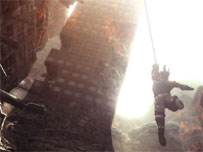Bionic Commando Dev All GRINsDate: Saturday, December 15 @ 03:57:56 UTC Bionic Commando developer GRIN reveals to Next-Gen the opening of a new studio, and the amount of creative influence that Capcom Japan will have on GRIN’s highly-anticipated grappler.  Commissioning GRIN, a Western developer, to handle one of Capcom’s most celebrated brands has some fans wary about the outcome. Will it still have some of that Japanese flavor, and how much influence will Capcom Japan have over the game? Andersson says that Capcom Japan has had a direct influence on creative aspects of the game, with top creatives from games like Devil May Cry and Resident Evil offering their feedback. Andersson compared the relationship to Capcom with that of Western publishers. “[Western publishers] very much like to have the producer come over and do check-ups,” he explains. “But Capcom is just more like a creative advisor, which I think is really cool. So they’re in on the creative side, and give a direct Japanese influence straight into the game design. “…The most interesting part is that our game gets thrown around to all the other departments within Capcom. The guys making Devil May Cry and Resident Evil and such. That’s really cool, because you get feedback from other creative directors and creative people from within the Japanese games industry while your game is in development. I’ve never experienced that in the Western industry. For me, that’s unparalleled.” And it’s hard not to talk about Bionic Commando’s trademark grappling hook and the plethora of gameplay possibilities that feature allows. “If you really want to push the PS3, you have to be able to pay for it as well.”“I’d say we’re still brainstorming [about how we can use the grappling hook],” he says. “We’re about 15 months into production, and every day someone comes up with a new idea. The first design session was really just two months of throwing stuff back and forth with a wire and doing a lot of concept art.” He says that he hopes to release that concept art after the game releases in an art book “to show people how long of a process it was to actually implement that mechnanic.” He adds, “It took us about a year to get everything right.” “PS3’s as complicated as you make it” GRIN is developing Bionic Commando for Xbox 360, PC and PS3, so Andersson is able to provide some insight into the challenges of multiplatform development. “[PS3’s] actually more complicated, because you have to pay attention to the hardware in a completely different way than the PC and 360,” he says, as different development methods are required when working with the PS3’s Cell processor and memory. “You have to be more careful about what you’re doing.” But he says that GRIN’s gameplay and controls are written in a separate language that is completely cross-platform. “The only thing that we actually change is the rendering device between 360 and PS3, as well as some of the memory management. “Where you can do the real magic on PS3 is in the optimization of the SPUs [synergistic processing units], but you’re not really required to do that—only if you really want to push the game and the platform, which is something we’re dedicated to doing.” Development of the PS3 engine is taking place at the new Barcelona studio, while the Stockholm offices have been developing the Xbox 360 and PC engines. “So developing for the PS3 is as difficult and costly as you make it,” he adds. “If you really want to push it, you have to be able to pay for it as well.” News-Source: Next-Gen |
This article comes from 360-HQ.COM:
https://www.360-hq.com
https://www.360-hq.com/article2164.html
